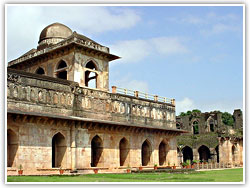|
intact
over an area of 12 square km. Mandu is situated on an
isolated hill top which is separated from the tableland
to the north by a deep and wide valley over which a
natural causeway runs to the main city gate. Mandu is
the largest standing fortified town in the world. The
walls of Mandu have a circumference of 75 km. The walls
look the same as they did some 300 years ago. There is
an abundance of mango, tamarind and banyan trees. The
city is particularly beautiful immediately after the
monsoons, a emerald green landscape full of waterfalls.
There are lakes, groves, gardens and palaces. The best
season to visit Mandu is from June to September, when
the tanks are full and the rain turns the entire
countryside into a verdant green.
History of Mandu
Mandu was founded by Raja Bhoj in the 10th century as a
fortress and retreat. It was taken over by Afghan rulers
in the 14th century. The hilltop fort of Mandu was
founded in the 10th century, but it was only in the 15th
century, under the rule of the Afghan governor of Malwa,
that it flourished. Most of its buildings like Jahaz
Mahal, Hindola Mahal, Rupamati’s Pavilion and the Jama
Masjid were erected between 1401 and 1529. Its
construction activity was at its peak under its two
rulers Mohamud Shah and Ghiasuddin. In 1469, the
sensualist Ghiyas-ud-din inherited the throne from his
father Mohammed Shah. The character of his reign is
typified by the Jahaz Mahal, which, with its vast rooms,
pools and decorative arches, was said to house
Ghiyas-ud-din 15,000 women. Mandu saw its greatest
spectacle on March 13,1617 when it heralded the entry of
Jahangir with a procession of 500 elephants. The Mughals
later took this fort from the Afghans. Under Mughal
rule, Humayun captured Mandu in a brilliant campaign in
Malwa in 1534, and it became a pleasure resort. However,
by the end of the Mughal period it had effectively been
abandoned and in 1732, it passed into Maratha hands. The
Marathas moved their capital to neighbouring Dhar,
leaving Mandu deserted as it is today.
Mandu is also known for a very romantic love story
between its last King Baz Bahadur and his love Rani
Rupmati – a lovely Rajput peasant girl. He fell in love
with Rupmati as he heard her singing in a forest and
brought her to his palace. He was so involved with her
that he built several buildings for his queen but had to
flee in the face of Akbar’s army. Rupmati was captured
for the pleasure of the Mughal General. But, before he
could touch her, she committed suicide by swallowing
ground diamonds. |
|
Tourist Attractions in Mandu
The tourist attractions in Mandu are the Jama
Masjid, Jahaz Mahal, Hindola Mahal, Nilkanth
Temple, Champa Baoli, Rewa Kund, Roopmati Pavilion
and Hoshang Shah’s Tomb. The Jama Masjid was
constructed on the lines of the Omayyed Mosque in
Damascus. This mosque is considered as the finest
example of Afghan architecture in India. This
mosque has so perfect acoustics that even a
whisper from the pulpits can be heard clearly in
the farthest corner of the courtyard. The
|
 |
|
|
Jahaz
Mahal is a palace shaped like a ship that floats
serenely on the bosom of the lake. Its shape and kiosks
looks like a heavenly ship sailing into eternity. This
long and narrow ship palace is built between two lakes
and looks like a pleasure boat. The Hindola Mahal is
built with its sloping walls that looks like a swing
with massive stone. It appears to sway gently in the
breeze.
More....
How to reach Mandu
By Air:
The nearest airport is located at Indore.
By Rail:
The nearest railway stations are located at Ratlam and
Indore on the Mumbai-Delhi Broad gauge line.
By Road:
Mandu lies just off NH3 from Agra to Mumbai. It is
accessible from Indore, Ratlam, Ujjain and Bhopal. |